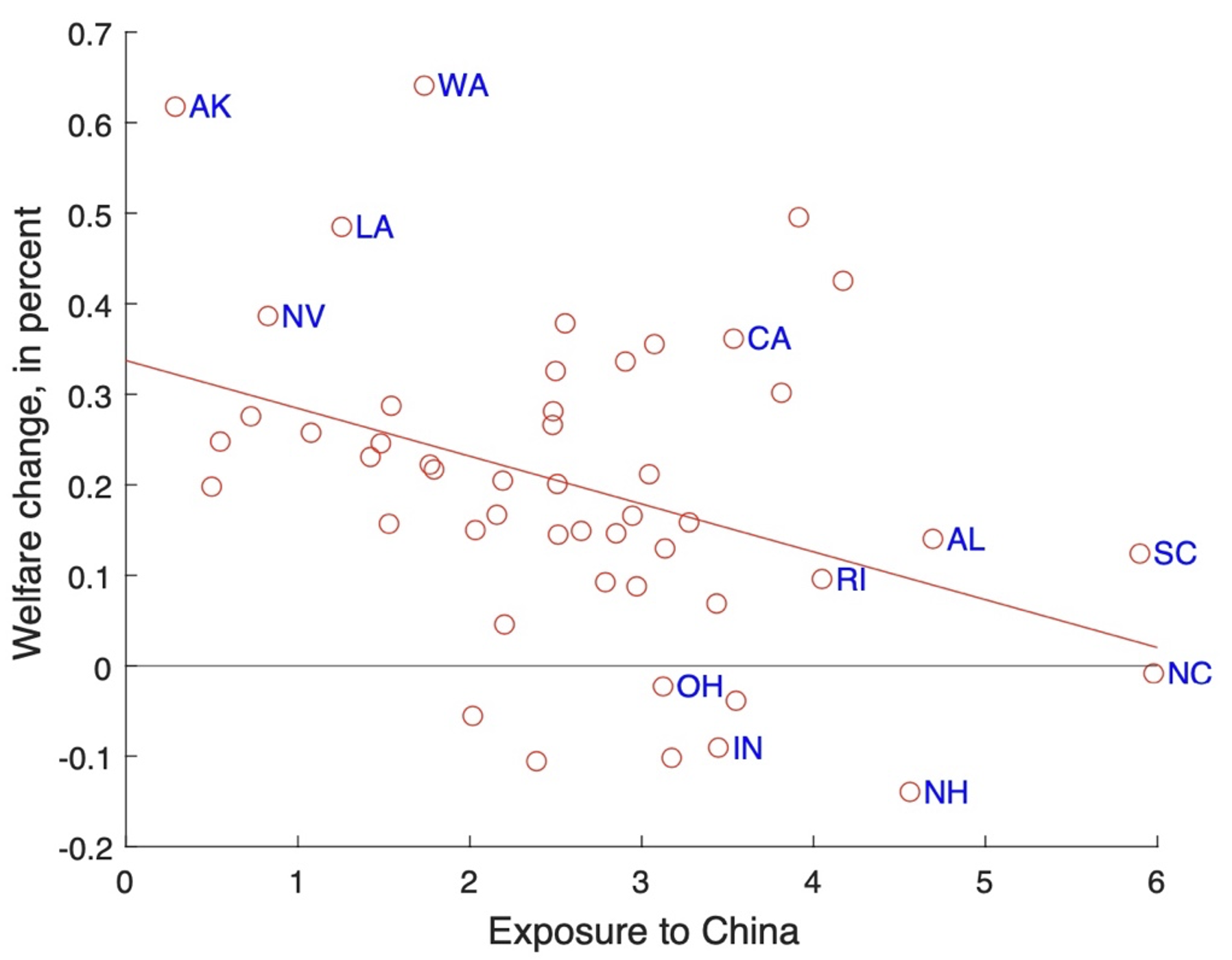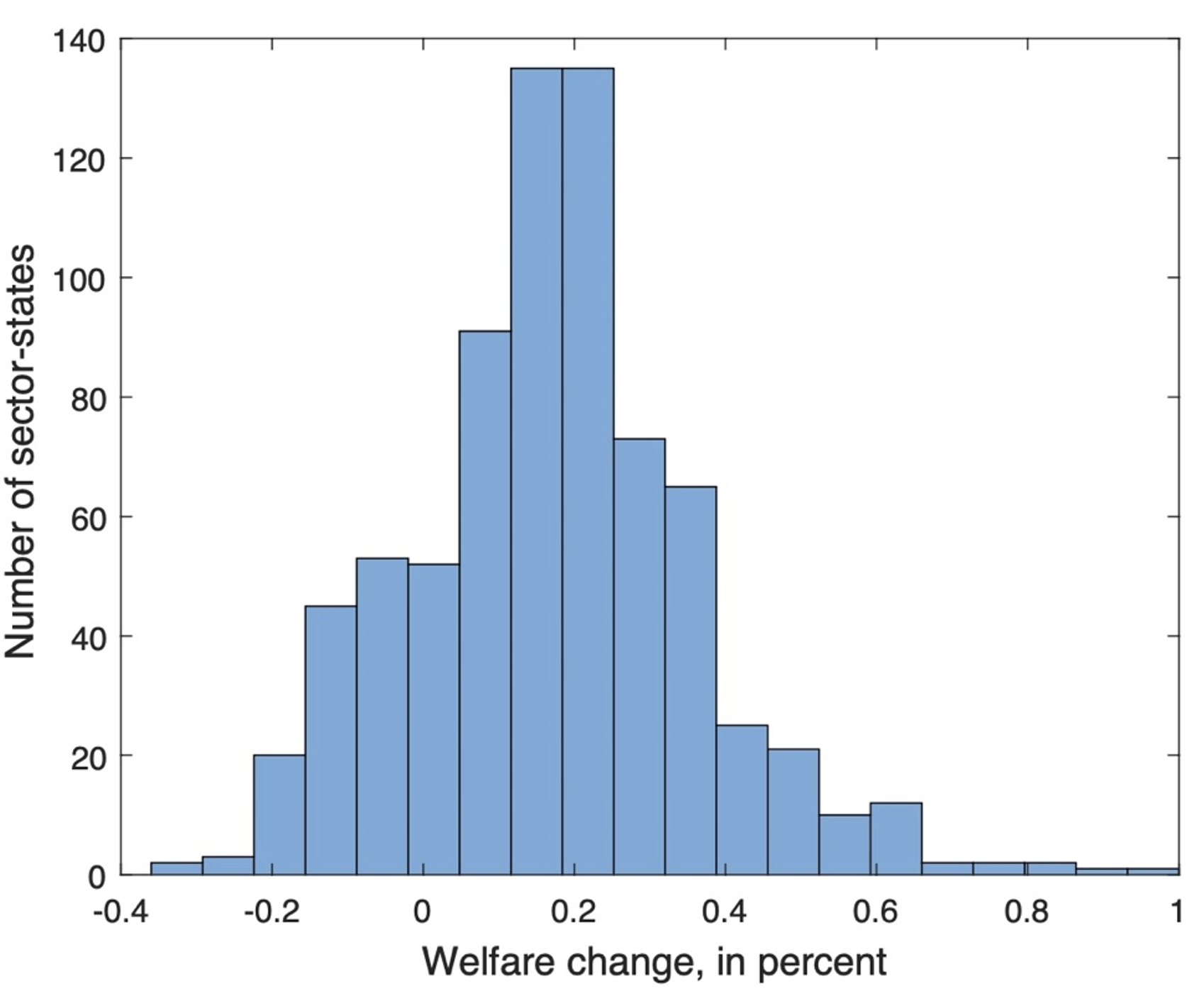One concern about international trade often raised by the public and the popular press is that it may destroy jobs and lead to unemployment. The debate about the potential gains from trade has become increasingly salient in the light of the growing evidence within high-income countries about the adverse employment effects in labour markets that are relatively more exposed to import competition from low-income countries such as China. These labour market effects are particularly important in localities whose employment relies relatively more on manufacturing, since firms in this sector have become less competitive against their Chinese counterparts (Dorn and Levell 2022, Grossman and Oberfield 2022).
In the US, the influential paper by Autor et al. (2013) finds that increased import competition from China (also referred to as the ‘China Shock’) caused relative increases in unemployment and decreases in labour force participation in commuting zones that were more exposed to the China Shock compared to those that were less exposed. These relative effects are hard to square with the predictions of standard trade models that do not feature unemployment. They suggest the presence of frictions that preclude the labour market from immediately adjusting after a trade shock.
To understand the labour market effects of trade, we present a model that allows us to quantify the aggregate implications of trade shocks while being consistent with the empirical facts uncovered by Autor et al. (2013) (Rodríguez-Clare et al. 2022). The key feature of this model is downward nominal wage rigidity, constraining the nominal wage to decrease no more than a certain percent per year and generating involuntary unemployment whenever the constraint is binding. We embed this feature into a dynamic trade and migration model in the spirit of Caliendo et al. (2019), which we extend further to allow for a difference between the elasticity governing workers’ mobility across sectors and the elasticity governing their mobility across local labour markets. Allowing for these different elasticities is crucial to match the empirical evidence from Autor et al. (2013). These elasticities, together with the degree of downward nominal wage rigidity, are the key parameters of the model.
The presence of downward nominal wage rigidity requires us to introduce a nominal anchor that prevents nominal wages from rising so much in each period as to make the constraint always non-binding. We choose a simple nominal rule that attempts to capture the idea that central banks are unwilling to allow inflation to be too high (because of its related costs) while at the same time being amenable for quantification in our trade setting. In particular, we assume that world nominal GDP in dollars grows at a constant and exogenous rate (which we set to zero without loss of generality). Then, as is common in the literature, we treat the China Shock as a productivity improvement in China that varies across sectors and years. We calibrate these productivity changes and the key model parameters to match the changes in US imports from China that we observe in the data (when projected on other rich countries changes in imports from China) as well as the regression results from Autor et al. (2013) on how labour force participation, unemployment, and population across US labour markets are affected by the China shock. This calibration procedure leads to a degree of downward nominal wage rigidity that implies that – with constant world nominal GDP – wages can fall up to 2% annually without the constraint becoming binding. This value is similar to the one in Schmitt-Grohe and Uribe (2016).
Armed with the calibrated version of our model, we simulate the effects of the China Shock for the 2000-2007 period using dynamic exact hat algebra, so that we do not need to explicitly calibrate sector-level trade costs and productivity levels in the initial year. We find that downward nominal wage rigidity has critical qualitative and quantitative implications for how US states adjust to the China shock. Specifically, we find that although the China shock improves the terms of trade for all but one US state, employment actually falls in most states during the transition, both due to an increase in unemployment and a decline in labour force participation. This means that downward nominal wage rigidity is not just amplifying the terms-of-trade effects, but it could also reverse those effects. For instance, a favourable terms-of-trade shock that requires a large enough nominal wage decline for the labour market adjustment would activate the nominal wage constraint and generate unemployment, which would be detrimental to the economy.
Intuitively, in a world with flexible wages, the increase in China’s relative productivity would require a downward adjustment in the US relative wage. Downward nominal wage rigidity prevents this adjustment from taking place through a large decline in the US nominal wage, and the nominal anchor prevents it from occurring through a large increase in the Chinese dollar wage. The result is temporary unemployment in the US. In turn, this unemployment triggers further declines in labour participation, as more workers prefer to opt-out of the labour market rather than face the possibility of being unemployed. Our model quantification implies that the China Shock leads to around half a million jobs lost in the US between 2000 and 2007. However, since the unemployment effect is reversed over time as the nominal wage adjusts downward, employment eventually increases after the economy fully adjusts to the positive terms-of-trade shock in the long run.
The spatial heterogeneity in the employment and income effects of the China Shock implied by our model is similar to that implied by the empirical results in Autor et al. (2013). This stands in contrast to previous quantitative trade models, such as Caliendo et al. (2019) and Galle et al. (2022), which deliver too little dispersion, as shown in Adao et al. (2020) and Autor et al. (2021). The main reason we obtain a higher dispersion is that, because of the downward nominal wage rigidity, our model leads to much larger declines in employment in the most exposed regions, both directly through higher unemployment and indirectly through discouraging labour participation.
One benefit of having the structure of a general equilibrium model is that we can study the effect of the China Shock on welfare. We find a negative relation between welfare changes and import exposure to China (see Figure 1). On the one hand, we find that an additional $1000 per worker in imports from China decreases state-level welfare by eight basis points. On the other hand, we find that despite the dispersion in welfare effects across state-sector pairs (see Figure 2), welfare increases in most US states, including many that experience unemployment during the transition. As a result, the China Shock is beneficial to the US, even with downward nominal wage rigidity. However, downward nominal wage rigidity has significant welfare implications, as it leads to a 25% reduction in the US gains from the shock (from 31 to 23 basis points) and to absolute welfare losses in seven states that would have benefited from the China Shock otherwise.
Figure 1 Welfare change versus exposure to the China Shock across US states
Figure 2 Histogram of welfare changes across different sector-states of the US
References
Adao, R, C Arkolakis and F Esposito (2020), “General equilibrium effects in space: Theory and measurement”, NBER Working Paper No. w25544.
Autor, D H, D Dorn and G H Hanson (2013), “The China Syndrome: Local Labor Market Effects of Import Competition in the United States”, American Economic Review 103(6): 2121-2068.
Autor, D H, D Dorn and G H Hanson (2021), “On the Persistence of the China Shock”, NBER Working Paper No. w29401.
Caliendo, L, M Dvorkin and F Parro (2019), “Trade and Labor Market Dynamics: General Equilibrium Analysis of the China Trade Shock”, Econometrica 87(3): 741-835.
Dorn, D and P Levell (2022), “Changing views on trade’s impact on inequality in wealthy countries”, VoxEU.org, 14 February.
Galle, S, A Rodríguez-Clare and M Yi (2022), “Slicing the Pie: Quantifying the Aggregate and Distributional Effects of Trade”, Review of Economic Studies, forthcoming.
Grossman, G and E Oberfield (2022), “Trying to account for the decline in the labour share”, VoxEU.org, 13 January.
Schmitt-Grohe, S and M Uribe (2016), “Downward Nominal Wage Rigidity, Currency Pegs, and Involuntary Unemployment”, Journal of Political Economy 124(5): 1466-1514.
Rodríguez-Clare, A, M Ulate and J P Vasquez (2022), “Trade with Nominal Rigidities: Understanding the Unemployment and Welfare Effects of the China Shock”, CEPR Discussion Paper 17141.








